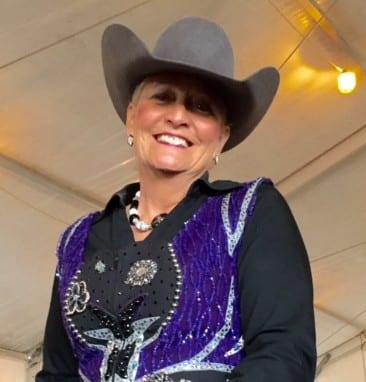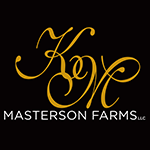GoHorseShow would like to thank Judge, Christa Baldwin of Stanton, Michigan for taking the time to break down the Congress Youth 15-18 and 12-14 Showmanship pattern for us. We thought it would be beneficial to our readers to find out from an AQHA Judge, whose customers have had success in this class, how she suggests the pattern should be executed. A huge bonus is that Baldwin is a judge at this year’s show.
The 2016 AQHA Professional Horsewoman of the Year, Baldwin specializes in all-around horses with many champions to her credit. As a carded AQHA judge, she has had the privilege of judging World Shows and major events all over the country.
We would also like to thank HorseShowPatterns.com for allowing us to post the pattern in the article. You may view the pattern that is displayed below or click here to download. GoHorseShow chose this pattern because we thought it would be beneficial to breakdown one of the more challenging patterns as some of the less complicated patterns having many of the same maneuvers.
Showmanship Pattern Breakdown as seen by Christa Baldwin
 This pattern has a lot of elements in it to show the communication between the exhibitor and their horse.
This pattern has a lot of elements in it to show the communication between the exhibitor and their horse.
- It starts out with an extended trot and a change to a regular trot halfway between B and C after turning a sharp corner to the Left. At C, break to a walk and walk around C. Establish a trot and trot a square corner to the right and stop at ring steward. Set up for Inspection and then pivot a 90* turn, back one horse length and execute another pivot of 540*. Trot straight away.
- Starting out – always, always make sure your horse is ready and straight at the cone in showmanship. So many times the exhibitor is on an angle and not set up square. This is the place to make that first impression. As often said, you only have one chance to make a first impression.
- After you are set up, according to the pattern and how it is drawn, you would move to the off side and be ready for your turn. Your horse should move off swiftly with you into an extended trot. This is where you have to know your horse. You do not want your horse to pop his head or resist in any way. So, if your horse is a little sluggish, you will want to move into that extended trot a little more smoothly and slower than someone whose horse can execute that move more crisply. It is about knowing your horse and how he reacts. If it is a smooth transition and the horse moves with you (even if a little slower), you may get a +1/2 or 0 on that transition but better than a -1/2 or -1 if he resists, pops his head and/or you have to pull on him.
- As you round B, you do not need to be on top of the cones. They are there for your guidance, not to see who can be the closest to them. So evaluate the cones and how they are set up and decide before hand where you are going and need to be to make your pattern look smooth and efficient.
- Between B and C, it calls for a transition to a regular trot. Be sure you have a change in speed but do not break to a walk as this is a break of gait, and a penalty. This takes a lot of practice; the horse does not show resistance but is a team with you.
- At C, you will break to a walk (simultaneous with you) and walk around C. This should not be sluggish but crisp and workmanlike. Pick up a trot and trot a square corner to the ring steward. This might be the trickiest spot since you first make a square corner and second, need to be in line with the ring steward at a blind spot to you being on the left side of your horse turning right, and at a trot, no less. If it isn’t exactly in front of the ring steward, you will have to correct your line. If it isn’t subtle, you will say to the judges, “Wow, I really missed that!” and get a lower score than if you gradually get in the straight line going to the ring steward, plus the horse will tell on you by lifting his head as you pull or push him quickly one way or the other.
- The stop is another critical aspect of showmanship as it tells how responsive the horse is. I teach my students to speed up slightly before they stop. It eliminates a horse (and showman) from dribbling and anticipating that stop. The horse also stops a little harder and many times stops square in back as they balance themselves with a stop that has more impulsion.
- The Setup and Inspection – I divide this into two separate columns on my score sheets as each is so important and may have different scores or penalties. The setup is so important. A quick and correct setup is always going to be a plus, whereas a slow setup or one that is not square will be a negative. So practice this a lot. I teach only to move one hind foot and be consistent teaching that.
- The inspection should be crisp but natural. There should be no curtsey or jerking of your head. However, I do want my exhibitor to check the horse as the ring steward is moving about the horse. After all, you are showing your horse and you should make sure your horse stays set up, is not resting, etc. I like to see the elbows bent and natural beside the body with the hands up somewhat, not the arms extended out with straight elbows. Look like you are enjoying it. Some people can smile easier than others, but you need a pleasant look on your face.
- After the inspection, it calls for a 90* turn and a back of one horse length. The turn should be sharp but not over or under turning. Practice finishing the turn and not leaving that left leg out. You may hesitate here before going into the turn or go right into it. That is up to you and your communication with your horse. Know your horse. The back should be crisp and not resistant to the exhibitor. Backing on a loose lead or with no resistance is a plus but resistance is a negative and standing directly in front of the horse is a severe penalty of 20 points.
- The last element of this pattern is the 540 degree turn and trot away. The turn should be crisp and smooth, only do what your horse and you are capable. The horse’s spine should be straight from hip to head and of course, must stay on the pivot foot to not accumulate penalty points. So many exhibitors try and do it faster than they are able to and get a horse that is being pushed and, therefore, the head is bent to the right and body gets out of position which can lead to mistakes and stepping out. The shoulder should lead not the head. The hind right leg (pivot leg) should stay straight up and down while executing the turn, and this will enable the horse to stay balanced on that leg and not step forward or backward. When finished, trot straight away and keep showing until you are out of the ring.
- Always keep showing through an entire pattern and never show in your face or your body language that you have made a mistake. That is part of showing and you may be surprised you can overcome some things if you keep showing. Your horse will also tell in his head and neck movements if he is resisting in the trot offs, backs, turns, etc. Practicing becoming a team is the only way to become successful in showmanship. I do like to see finishing one element of the pattern before going into the next, but again it is what you and your horse can do to present an overall, pleasant, fluid and a non-resistant performance.
- Last, I would like to add, read your rulebook and know what is expected of you. The Minor, Major, and Severe Faults are listed as well as Disqualifications. Also, the maneuver scores and final scoring is broken down there. Good Luck and enjoy!
 About the Author
About the Author
AQHA Judge Christa Baldwin was named the 2016 AQHA Professional Horsewoman of the Year. She is also a judge at this year’s Congress, and her daughter, Brandy, is currently leading the nation for the Amateur All-Around. Baldwin is currently on the Pro Horseman’s Council and has served on the Show committee, International and the Judges committee for AQHA. Christa is from Stanton, Michigan and specializes in training all-around horses.








